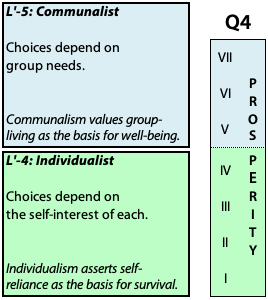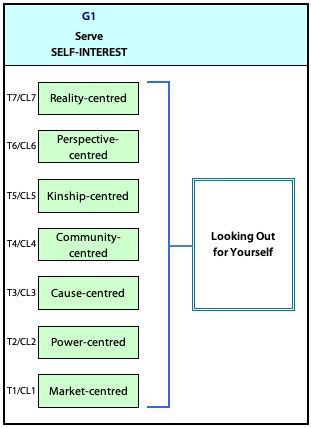Looking Out for Yourself in Society
An Everyday Self and our Better Self

The taxonomy has put flesh on the truism that each of us is egotistical and yet we must protect the socio-physical environment on which we depend. Unrestrained individualism leads to the tragedy of the commons—the destruction of goods that we all share.
Investigation of methods for getting benefit from our interactions with others generated a structure in which common-sense was confirmed.
This framework turned out to be part of a which is created by a combination of and .
Intuitively, we are aware that there is more to life than rank individualism, even if modulated by communalism. Taxonomic investigation confirmed this sense when it revealed the presence of a «better self» within the Root complex. The calls for egotism to be transcended, not least because it is the source of evil.
However, the better self is not a replacement for our everyday self. We must not, indeed cannot, neglect our everyday self. The only people who can do that are those, like Buddhist monks and Hasidic rabbis, who are actively and continuously respected and supported by their local community.
It is our everyday self that provides our shelter, our nourishment, our clothing, our health and our social life. It ensures we are protected against the weather, against those who seek to do us harm, and even against bad luck. It delivers us comforts, pleasures and entertainments. Our better self offers guidance in pursuing these needs and desires, but that is all it can do.
Naming

The framework to be developed here could be entitled «Looking after Yourself», but the problem for our everyday self is that everyone wants the same thing. Everyday life has an unavoidable competitive element. To ignore that is to fail to handle yourself effectively. So the framework is entitled, perhaps provocatively for those who see individualism as the bane of society, «».
Financial security, the Spiral evolution which draws successively and cumulatively on all the , contributes to looking after yourself. The Tree pattern, which emerges from that spiral pattern, provides a framework for social standing, which is the unavoidable context for all personal efforts on your own behalf.
All the interacting-for-benefit approaches are self-serving. Taking them together will therefore maximize the pursuit of self-interest. As in previous similar frameworks, a key value from each approach must be identified. Treating these as monads to be combined in a structural hierarchy can be expected to identify essential components for self-management and self-sufficiency, insofar as that is possible.
The Structural Hierarchy
The taxonomic form that provides for the necessary cumulation of key interacting-or benefit values is a Structural Hierarchy. Each Level in such a hierarchy is a Grouping and contains all Levels of the originating hierarchy, the in this case. This section will investigate the Groupings and offer provisional formulations which deserve further checking and refinement.
The Groupings and their Groups are ways to overcome the differentiation and discontinuity demanded by the hierarchical stratification of approaches to benefiting. They have unique functions and properties and explain phenomena easily noticed in social life.
Get Started
- Preview the structural hierarchy in terms of the function, requirement and state of each of the groupings.
- To get a further feel for the hierarchy, see an account of the battle between self-assertion and psychosocial realism.
-
See the full picture and summary tables in the review section.
OR
- Start with serving self-interest–G1 Monads.
Originally posted: 10-July-2025.
